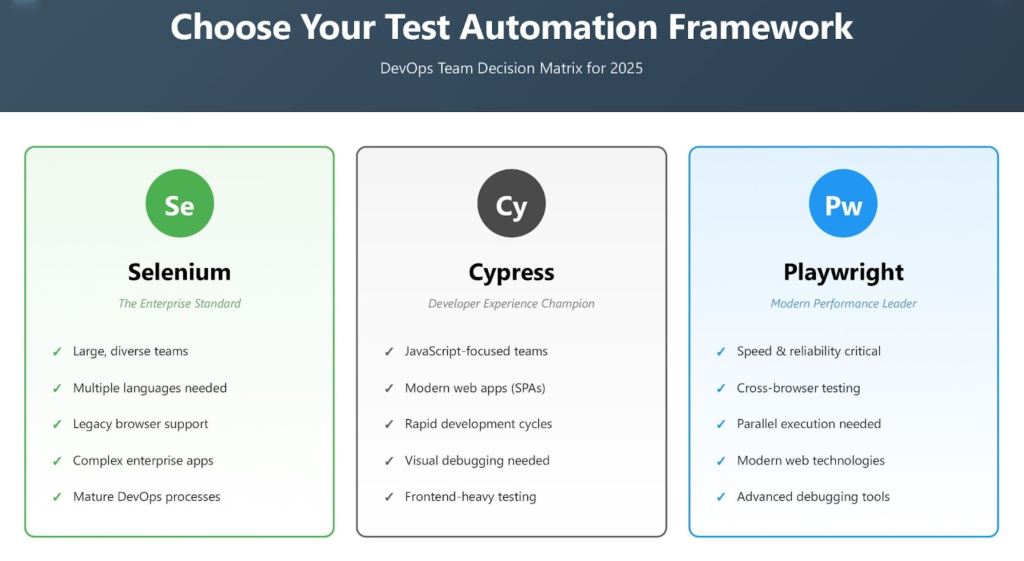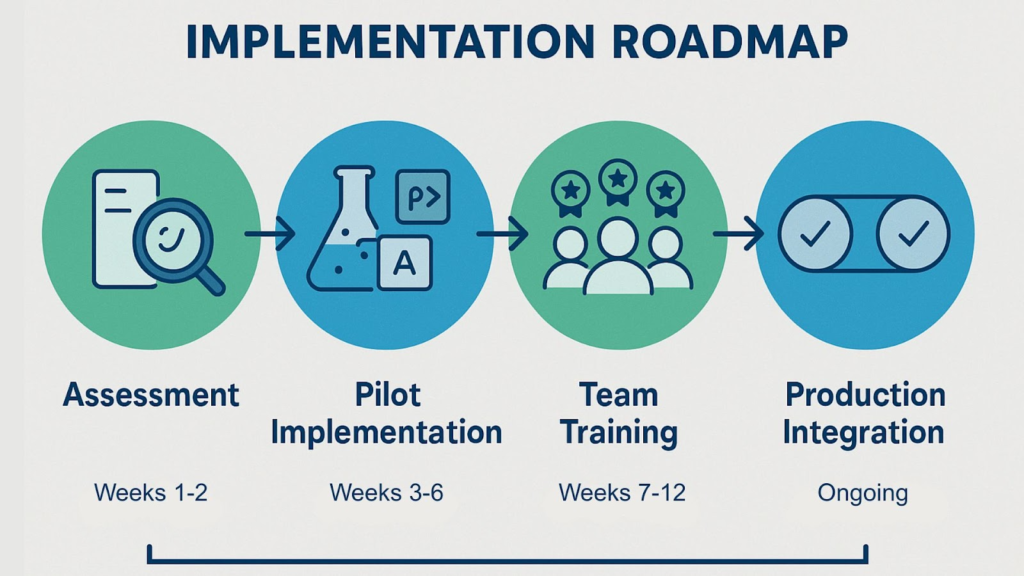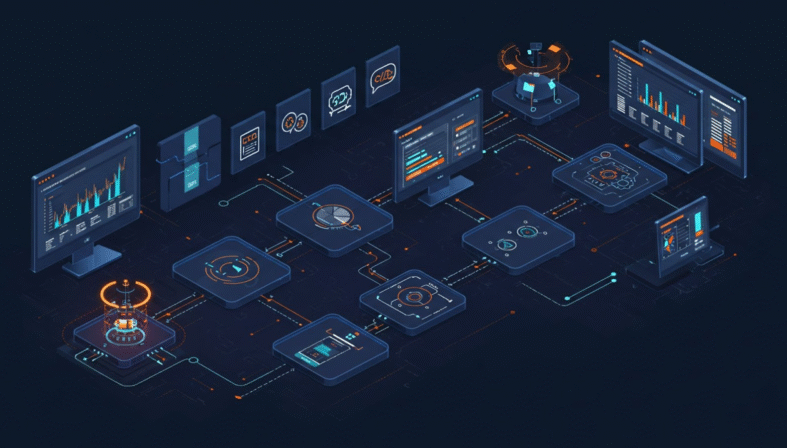DevOps teams need frameworks that integrate seamlessly with CI/CD pipelines, support rapid deployment cycles, and provide clear visibility into quality and speed. A robust test management strategy ties these elements together.
- Market leadership continues: Selenium remains the most adopted framework, but newer tools like Playwright are gaining ground with superior DevOps integration capabilities
- AI transformation accelerating: Teams are actively exploring AI-driven testing workflows, with automation efficiency improvements reported across organizations
- Cross-platform dominance emerging: 85% of enterprises are expected to adopt cross-platform test automation tools by 2025, driven by multi-experience application demands
- Strategic selection matters: Choose frameworks based on team expertise, CI/CD maturity, specific project requirements, and how effectively they integrate into your overall test management strategy rather than following trends blindly
The right framework can reduce testing time while improving accuracy and accelerating release cycles in modern DevOps environments.
DevOps teams face a challenge: delivering quality software at lightning speed while managing increasingly complex technology stacks. The test automation market is exploding, projected to reach $63.05 billion by 2032, and choosing the right automation frameworks has become mission-critical for staying competitive.
The pressure is real. According to industry data, 55% of teams cite insufficient time for thorough testing as their biggest quality challenge, while 44% struggle with overwhelming workloads. The best test automation frameworks can transform your DevOps pipeline from a bottleneck into a competitive advantage.
But here's the thing: not all frameworks are equal, especially when it comes to DevOps integration. While some excel at basic test execution, others are built from the ground up to support continuous integration, parallel testing, and seamless deployment workflows.
What Makes Test Automation Frameworks Essential for DevOps Success?
DevOps is about moving fast while maintaining quality, reliability, and team sanity. Traditional manual testing can't keep up with the demands of continuous deployment, where code changes can hit production multiple times per day.
One-fifth of teams using automation tools report replacing up to 75% of their manual testing efforts, with 26% of organizations automating at least half of their test cases. API testing leads automation adoption at 84%, followed by user interface testing at 52%. Teams need frameworks that can handle both backend services and frontend experiences across multiple environments simultaneously.
Modern DevOps teams require frameworks that offer:
Seamless CI/CD Integration: Tools that plug directly into Jenkins, GitHub Actions, GitLab CI, and Azure DevOps without complex configuration gymnastics.
Parallel Execution Capabilities: The ability to run tests concurrently across multiple browsers, devices, and environments to maximize throughput.
Real-time Feedback Loops: Immediate test results and centralized reporting that help developers catch issues before they cascade through the pipeline, facilitating quicker resolutions and informed decisions.
Cross-platform Coverage: Support for web, mobile, and API testing within unified workflows, ensuring comprehensive coverage and enabling a single source of truth for all test artifacts, which seamlessly matches your technology stack.
The shift toward DevOps practices has grown from 16.9% adoption to 52% by 2024, and teams embracing these methodologies are seeing defect rates drop while accelerating time-to-market.
Which Framework Categories Matter Most for DevOps Teams?
DevOps success is about knowing which categories of the best test automation frameworks will give your team the biggest impact. By focusing on the areas that matter most, you can streamline workflows and keep quality moving at the speed of delivery.
Web Application Testing Powerhouses
Web testing remains the backbone of most automation strategies, but DevOps teams need more than basic browser automation. They need frameworks that understand modern web architectures, handle single-page applications gracefully, and provide debugging capabilities that don't slow down development cycles.
Selenium continues dominating this space with its mature ecosystem and extensive language support. Its WebDriver protocol has become the de facto standard, but setup complexity and maintenance overhead can challenge teams focused on rapid iteration.
Cypress revolutionized web testing with its developer-first approach, offering real-time browser previews and simplified debugging. However, its same-origin policy limitations can create challenges for complex multi-domain testing scenarios.
Playwright emerged as the modern alternative, providing fast, reliable testing across multiple browser engines with built-in parallel execution and advanced debugging tools that DevOps teams love.
API Testing Integration Champions
API testing automation has become non-negotiable for DevOps teams managing microservices architectures. With teams automating API testing, the frameworks you choose here directly impact your ability to catch integration issues early.
Postman and Newman lead this category with their user-friendly interface and robust CI/CD integration capabilities. Teams can design tests visually and execute them programmatically within deployment pipelines.
REST Assured offers Java-based teams a powerful testing framework that integrates naturally with existing development toolchains and provides extensive validation capabilities for complex API responses.
Mobile Testing Solutions for Multi-Platform Teams
Mobile testing automation is exploding, with the market expected to generate $8.23 billion in revenue by 2025. DevOps teams need frameworks that can handle both native and hybrid applications across iOS and Android platforms without doubling their maintenance burden.
Appium remains the cross-platform leader, allowing teams to write tests once and execute them across multiple mobile platforms using familiar WebDriver protocols.
The trend toward mobile-first development means DevOps teams can no longer treat mobile testing as an afterthought. It needs to be integrated into the same continuous testing workflows that handle web and API validation.
Which Are the 8 Best Test Automation Frameworks for DevOps Teams in 2025?
Here's the definitive breakdown of frameworks that are actually moving the needle for DevOps teams in 2025:
1. Selenium WebDriver - The Reliable Veteran
Selenium maintains its position as the most widely adopted framework for good reason. With support for Java, Python, C#, Ruby, and JavaScript, it fits into virtually any development environment. Its extensive third-party ecosystem and mature tooling make it a safe bet for enterprise DevOps teams.
DevOps Strengths: Excellent CI/CD tool integration, massive community support, works with existing infrastructure investments.
Best For: Large enterprises with diverse technology stacks and teams that need maximum flexibility.
2. Playwright - The Modern Performance Leader
Playwright has rapidly gained traction, surpassing Cypress in npm downloads. Built by Microsoft's team, it offers superior cross-browser testing with built-in parallel execution and advanced debugging capabilities that DevOps teams find irresistible.
DevOps Strengths: Native parallel testing, excellent CI/CD integration, comprehensive browser coverage, minimal setup requirements.
Best For: Teams prioritizing speed, reliability, and modern web application testing.
3. Cypress - The Developer Experience Champion
Cypress transformed web testing with its innovative approach to developer experience. Real-time browser previews, time-travel debugging, and simplified test writing make it popular among development teams that value rapid feedback loops.
DevOps Strengths: Exceptional debugging capabilities, simple setup process, strong community ecosystem, excellent documentation.
Best For: Frontend-focused teams building modern single-page applications.
4. TestCafe - The Zero-Configuration Solution
TestCafe eliminates browser driver management complexity while providing robust cross-browser testing capabilities. Its TypeScript and JavaScript support, combined with built-in waiting mechanisms, reduces test flakiness that can derail CI/CD pipelines.
DevOps Strengths: No WebDriver dependencies, built-in parallel execution, excellent CI/CD integration.
Best For: Teams wanting reliable automation without configuration overhead.
5. Katalon Studio - The All-in-One Platform
Katalon offers a comprehensive testing platform combining web, mobile, and API testing capabilities with built-in test management features. Recent surveys show it among the top three most popular automation tools for integrated workflows.
DevOps Strengths: Unified platform approach for test management, extensive integrations, built-in reporting and analytics.
Best For: Teams seeking comprehensive testing solutions with minimal tool sprawl.
6. Robot Framework - The Keyword-Driven Approach
Robot Framework's keyword-driven methodology enables non-technical team members to contribute to test automation while maintaining powerful scripting capabilities for complex scenarios.
DevOps Strengths: Human-readable test cases, extensive library ecosystem, supports multiple automation approaches.
Best For: Organizations with mixed technical skills wanting collaborative test creation.
7. REST Assured - The API Testing Specialist
For Java-based teams, REST Assured provides the most natural API testing experience with powerful validation capabilities and seamless integration with existing development workflows.
DevOps Strengths: Native Java integration, powerful assertion capabilities, excellent Maven/Gradle support.
Best For: Java-centric DevOps teams focusing on microservices testing.
8. Postman/Newman - The API Testing Democratizer
Postman's visual interface combined with Newman's command-line execution creates an ideal bridge between manual API exploration and automated testing within CI/CD pipelines.
DevOps Strengths: Visual test creation, robust CI/CD integration, collaborative features, extensive documentation capabilities.
Best For: Teams needing both manual API testing capabilities and automated execution.
How Do You Choose the Right Framework for Your DevOps Pipeline?
The three-way battle between Selenium, Cypress, and Playwright dominates most DevOps framework discussions. Here's how they stack up across the factors that actually matter for continuous delivery:
| Feature | Selenium | Cypress | Playwright |
| Setup Complexity | High - Requires driver management | Low - Single npm install | Low - Built-in browser binaries |
| Parallel Execution | Requires Selenium Grid setup | Paid feature or complex setup | Built-in, free |
| Language Support | Java, Python, C#, Ruby, JS | JavaScript/TypeScript only | JavaScript, Python, Java, C# |
| Cross-browser Testing | Excellent - All browsers | Limited - Chromium family focus | Excellent - Chromium, Firefox, Safari |
| CI/CD Integration | Mature but complex | Good with caveats | Excellent out-of-box |
| Debugging Experience | Plugin-dependent | Outstanding | Advanced built-in tools |
| Learning Curve | Steep for beginners | Moderate | Gentle with good docs |
| Community Support | Massive, mature | Strong, growing | Rapidly expanding |
| Mobile Testing | Via Appium integration | Limited emulation | Built-in mobile emulation |
This comparison reveals why Playwright has been gaining momentum. It delivers the cross-browser capabilities of Selenium with the developer experience advantages that made Cypress popular, while adding built-in parallel execution that DevOps teams desperately need.

However, the "best" choice depends entirely on your specific context. Selenium remains unmatched for complex, multi-language enterprise environments. Cypress excels when developer experience and rapid iteration matter more than broad browser coverage.
Teams should evaluate frameworks against their actual requirements rather than chasing the latest trends. A Python-heavy data science team might find Selenium with pytest integration more valuable than the latest JavaScript-focused framework. For teams weighing specific technical trade-offs, our detailed Playwright vs Selenium analysis provides deeper insights into performance and integration capabilities.
What Emerging Trends Will Shape Framework Selection in 2025?
Testing is moving into a new era, and the best test automation frameworks are evolving to keep pace. Advances like AI-powered testing, no-code platforms, and cloud-native execution are redefining how DevOps teams select and apply their automation tools.
AI-Powered Testing Integration
The integration of AI into test automation is the biggest shift since the move from manual to automated testing. With teams actively exploring AI-driven workflows, frameworks are rapidly adding intelligent capabilities that surpass simple test execution.

Modern AI integration includes self-healing test scripts that automatically adapt to UI changes, intelligent element location that reduces test brittleness, and predictive failure analysis that helps teams focus debugging efforts.
Selenium is expanding AI capabilities through third-party integrations, while newer frameworks like Playwright are building intelligence directly into their core architecture. Teams report improvements in automation efficiency when leveraging AI-enhanced frameworks.
No-Code and Low-Code Revolution
The democratization of test automation through no-code and low-code platforms is transforming how DevOps teams approach testing. Statistics show that 70% of new applications will use low-code or no-code technologies by 2025, and testing frameworks are following suit.
This trend enables business analysts, product managers, and domain experts to contribute directly to test automation without deep programming knowledge. Tools like Katalon Studio are leading this charge with visual test creation capabilities that generate maintainable automation scripts.
This shift also aligns well with behavior-driven development (BDD) practices, where frameworks support writing human-readable test specifications using Gherkin syntax, further bridging the gap between business stakeholders and technical teams.
The impact on DevOps teams is profound: faster test creation, broader team participation in quality assurance, and reduced bottlenecks around specialized automation skills.
Cloud-Native Testing Approaches
The shift toward distributed cloud architectures is changing how frameworks handle test execution. Teams are moving beyond cloud-hosted Selenium grids toward truly cloud-native solutions that provide elastic scaling, geographic distribution, and integrated monitoring.
Playwright and Cypress both offer excellent cloud integration capabilities, while traditional Selenium setups require more configuration to achieve similar results. Teams can run thousands of tests in parallel across global infrastructure without managing complex local grid setups.
This trend aligns perfectly with the DevOps principle of treating infrastructure as code. Test execution environments become another deployable resource rather than a persistent maintenance burden.
How Should DevOps Teams Implement New Testing Frameworks?
Adopting a new framework is about rolling new automation tools out in a way that fits your team’s workflows. A phased approach helps DevOps teams minimize disruption, build confidence, and effectively scale automation.

Phase 1: Assessment and Planning (Weeks 1–2)
Start by auditing your current testing landscape and DevOps maturity level. Teams with established CI/CD pipelines can move faster than organizations still building their automation foundation.
Key assessment questions include: What's your primary technology stack? How mature are your DevOps practices? What's your team's current automation experience level? Do you need immediate results, or can you invest in longer term capabilities?
Document your current manual testing processes and identify the highest impact automation candidates. API tests typically provide the best ROI, followed by critical user journey automation that catches regression issues early.
Phase 2: Pilot Framework Implementation (Weeks 3–6)
Choose two to three frameworks from your shortlist and implement proof-of-concept projects that reflect your actual testing needs. Avoid toy examples. Instead, use real applications with real complexity to understand how each framework handles your specific challenges.
Focus on integration capabilities during this phase. How easily does each framework integrate with your existing CI/CD tools? What's the developer experience like for your actual team members? How much maintenance overhead does each approach require?
Phase 3: Team Training and Scaling (Weeks 7–12)
Once you've selected your primary framework, invest heavily in team training and best practice development. The most sophisticated framework becomes useless if your team can't leverage its capabilities.
Develop coding standards, review processes, and maintenance procedures that align with your DevOps workflows. Create reusable test components and establish patterns that enable rapid test creation without sacrificing maintainability.
Phase 4: Production Integration and Optimization (Ongoing)
Integrate your chosen framework into production deployment pipelines with appropriate failure handling and reporting mechanisms. Monitor test execution times, failure rates, maintenance overhead, and overall test coverage through your test management platform to identify optimization opportunities and track quality metrics.
Establish metrics that matter: test coverage, defect detection rates, deployment frequency, and mean time to recovery. These indicators help you measure the real business impact of your framework investment.
The most successful DevOps teams treat test automation as a product rather than a project, continuously improving, optimizing, and expanding their capabilities based on real usage data and business outcomes.
Frequently Asked Questions
Which test automation framework offers the best ROI for DevOps teams starting their automation journey?
For teams just beginning their automation journey, Cypress typically provides the fastest time-to-value due to its simple setup and excellent developer experience. However, if your team has diverse language requirements or needs extensive cross-browser testing, Selenium might offer better long-term ROI despite higher initial complexity. The key is matching framework capabilities to your specific team skills and project requirements rather than choosing based on popularity alone.
How do I migrate from an existing framework to a more modern solution without disrupting our CI/CD pipeline?
The safest migration approach involves running both frameworks in parallel during a transition period. Start by implementing new test cases in your target framework while maintaining existing tests in the current system. Gradually port your highest value tests to the new framework, beginning with the most stable and critical functionality.
What's the total cost of ownership difference between open-source and commercial automation frameworks?
While open-source frameworks like Selenium and Playwright have no licensing costs, the total cost of ownership includes setup time, maintenance overhead, training requirements, and infrastructure expenses. Commercial platforms often provide faster setup and integrated tooling but require ongoing subscription costs. Teams should calculate TCO based on their specific context. Developer hourly rates, infrastructure costs, and long-term maintenance requirements typically outweigh initial licensing considerations.
How important is AI integration in framework selection?
AI integration is becoming increasingly important. However, AI should enhance rather than drive your framework selection. Choose frameworks with solid fundamental capabilities and clear AI integration roadmaps rather than bleeding-edge AI tools that might lack stability. The most practical AI benefits currently include self-healing test scripts and intelligent element location rather than fully autonomous test generation.
Can multiple frameworks coexist within a single DevOps pipeline?
Yes, and many successful DevOps teams use different frameworks for different testing types. For example, REST Assured for API testing, Cypress for critical user journeys, and Appium for mobile applications. The key is maintaining consistent reporting, failure handling, and integration patterns across all frameworks, ideally centralized within a unified test management solution. Avoid framework proliferation for its own sake. Each additional tool increases maintenance overhead and team cognitive load.
Transform Your DevOps Testing Strategy Today
The best test automation frameworks analyzed here represent proven solutions that transform DevOps pipelines from quality bottlenecks into competitive advantages.
Success comes from selecting tools that align with your team's skills, project requirements, and long-term strategic goals rather than chasing trends. Whether you choose Selenium's reliability, Cypress's developer experience, or Playwright's modern capabilities, implementation excellence and continuous optimization determine real results.TestQuality provides a unified test management platform that connects your automation frameworks, offering comprehensive reporting, requirement traceability, and seamless DevOps integration. To learn more about how TestQuality's features can help your team move faster and maintain quality standards, explore our dedicated features page. Start a trial today to enhance your strategy with free tools.





